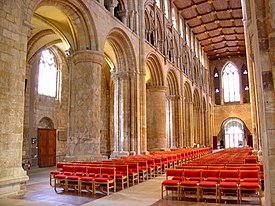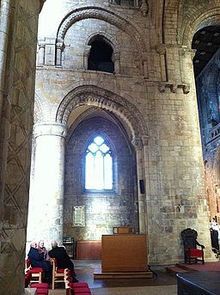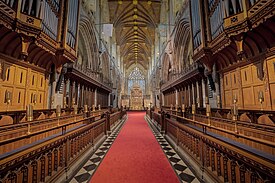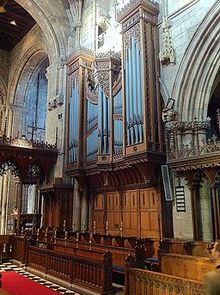Selby Abbey
This privilege fell into abeyance a number of times, but on 11 April 1308, Archbishop William Greenfield confirmed the grant, and Selby remained a "Mitred Abbey" until the Dissolution of the Monasteries.
[4] Archbishop Walter Giffard visited the monastery in 1275 by commission, and several monks and the abbot were charged with a list of faults including loose living: many complaints referred to misconduct with married women.
In 1279 Archbishop William de Wickwane made a visitation, and found fault with the abbot as he did not observe the Rule of Saint Benedict, was not singing mass, preaching or teaching, and was seldom attending chapter.
[4] The community rebuilt the choir in the early 14th century, but in 1340 a fire destroyed the chapter house, dormitory, treasury and part of the church.
[4] In 1393 Pope Boniface IX granted an indulgence to pilgrims who contributed to the conservation of the chapel of the Holy Cross in the abbey.
During the English Civil War and the Commonwealth period the building suffered: the north transept window was destroyed, and the statues on the brackets in the choir were demolished.
All of the interior fittings were also destroyed but thanks to the actions of the local fire brigade, the fourteenth-century stained glass in the East window was saved.
The £400,000 cost of restoring the South choir Aisle and the "Washington Window" was met in full by British American Tobacco.
It is believed the shield is in the Abbey thanks to a financial benefaction supporting the work of the monastery at Selby from John Wessington, one of George Washington's ancestors, who was Prior of Durham from 1416 to 1446, and the design is thought to be one of the oldest representations of the Flag of the United States in the world.
[17] Music at Selby Abbey has a long history going back to its monastic foundation in the 11th century when plainsong was chanted at the daily services by the Benedictine monks.
While the choir consists principally of dedicated volunteers, the Abbey provides three Choral Scholarships and employs a professional Director of Music, and Assistant Organist.
[citation needed] Following the 1906 fire[19] and as part of the subsequent restoration of the Abbey, the firm of William Hill & Son was commissioned to build the current organ, completed in 1909.
[20] With 67 speaking stops and 4 manuals, most of the pipes of this instrument occupy two organ cases designed by John Oldrid Scott and placed either side of the choir stalls in the Chancel.
In 2014, Geoffrey Coffin and Principal Pipe Organs of York were commissioned to carry out a major restoration with Paul Hale as the adviser.





